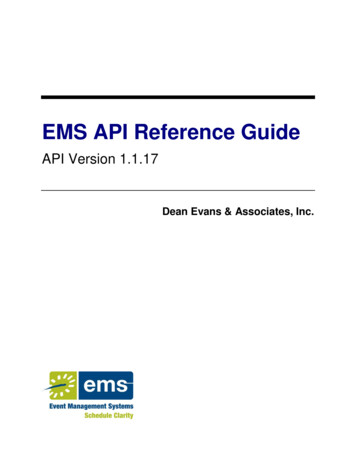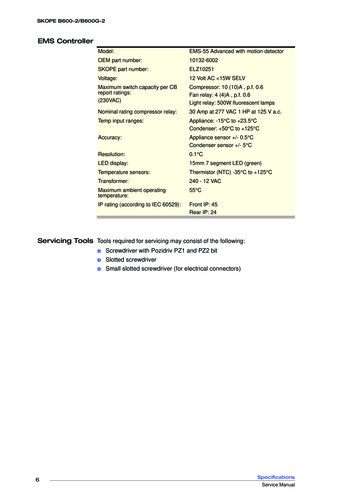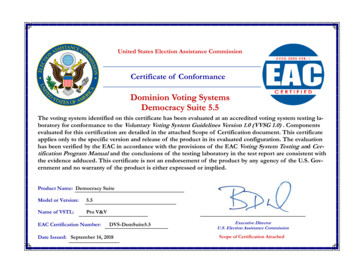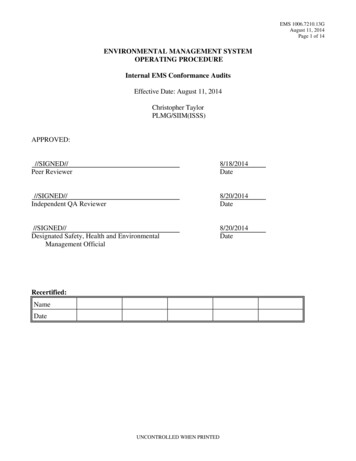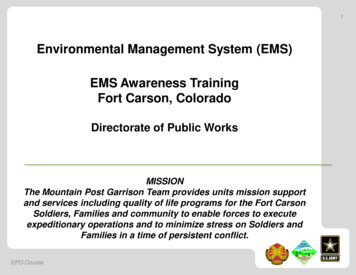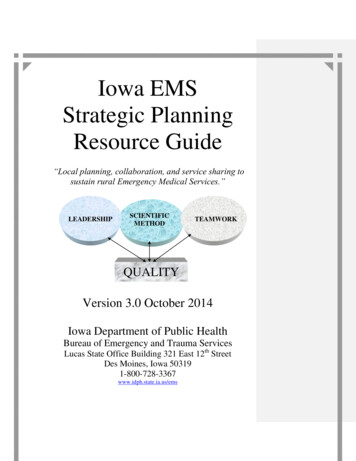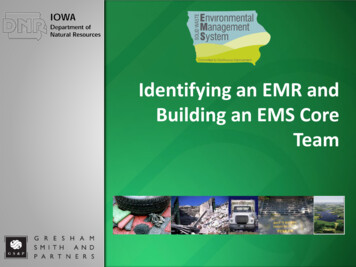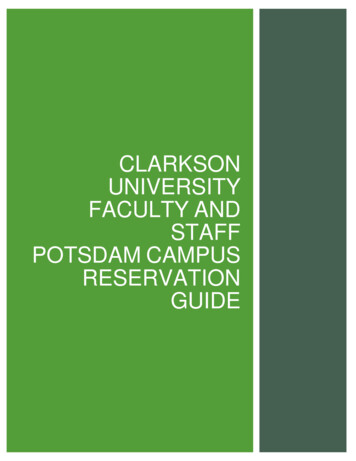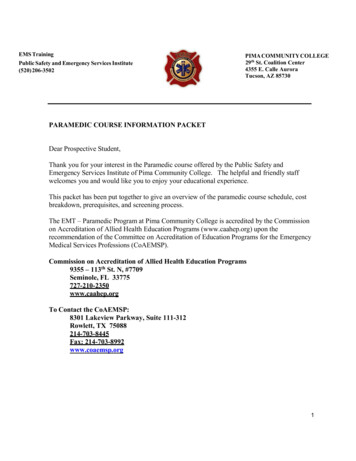
Transcription
EMS TrainingPublic Safety and Emergency Services Institute(520) 206-3502PIMA COMMUNITY COLLEGE29th St. Coalition Center4355 E. Calle AuroraTucson, AZ 85730PARAMEDIC COURSE INFORMATION PACKETDear Prospective Student,Thank you for your interest in the Paramedic course offered by the Public Safety andEmergency Services Institute of Pima Community College. The helpful and friendly staffwelcomes you and would like you to enjoy your educational experience.This packet has been put together to give an overview of the paramedic course schedule, costbreakdown, prerequisites, and screening process.The EMT – Paramedic Program at Pima Community College is accredited by the Commissionon Accreditation of Allied Health Education Programs (www.caahep.org) upon therecommendation of the Committee on Accreditation of Education Programs for the EmergencyMedical Services Professions (CoAEMSP).Commission on Accreditation of Allied Health Education Programs9355 – 113th St. N, #7709Seminole, FL 33775727-210-2350www.caahep.orgTo Contact the CoAEMSP:8301 Lakeview Parkway, Suite 111-312Rowlett, TX 75088214-703-8445Fax: 214-703-8992www.coaemsp.org1
Functional Job AnalysisParamedic CharacteristicsThe Paramedic must be a confident leader who can accept the challenge and high degree ofresponsibility entailed in the position. The Paramedic must have excellent judgment and beable to prioritize decisions and act quickly in the best interest of the patient, must be self disciplined, able to develop patient rapport, interview hostile patients, maintain safedistance, and recognize and utilize communication unique to diverse multicultural groupsand ages within those groups. Must be able to function independently, at optimum level, ina non-structured environment that is constantly changing.Even though the Paramedic is generally part of a two- person team generally working with alower skill and knowledge level Basic EMT, it is the Paramedic who is held responsible forsafe and therapeutic administration of drugs including narcotics. Therefore, the Paramedicmust not only be knowledge about medications but must be able to apply this knowledge ina practical sense.Knowledge and practical application of medications include thoroughly knowing andunderstanding the general properties of all types of drugs including analgesics, anesthetics,anti-anxiety drugs, sedatives and hypnotics, anti-consultants, central nervous stimulants,psychotherapeutics which include antidepressants, and other anti-psychotics,anticholerginics, cholergenics, muscle relaxants, anti-dysrythmics, anti-hypertensives,anticoagulants, diuretics, bronchodilators, opthalmics, pituitary drugs, gastro-intestinaldrugs, hormones, antibiotics, antifungals, antiinflammatories, serums, vaccines, antiparasitics, and others.The Paramedic is personally responsible, legally, ethically, and morally for each drugadministered, for using correct precautions and techniques, observing and documenting theeffects of the drugs administered, keeping one’s own pharmacological knowledge- basecurrent as to changes and trends in administration and use, keeping abreast of allcontraindications to administration of specific drugs to patients based on their constitutionalmake-up, and using drug reference literature.The responsibility of the Paramedic includes obtaining a comprehensive drug history from thepatient that includes names of drugs, strength, daily usage and dosage. The Paramedic musttake into consideration that many factors, in relation to the history given, can affect the typemedication to be given. For example, some patients may be taking several medicationsprescribed by several different doctors and some may lose track of what they have or have nottaken. Some may be using non- prescription/over the counter drugs. Awareness of drugreactions and the synergistic effects of drugs combined with other medicines and in someinstances, food, is imperative. The Paramedic must also take into consideration the possible1
risks of medication administered to a pregnant mother and the fetus, keeping in mind thatdrug’s may cross the placenta.The Paramedic must be cognizant of the impact of medications on pediatric patients based onsize and weight, special concerns related to newborns, geriatric patients and the physiologicaleffects of aging such as the way skin can tear in the geriatric population with relatively littleto no pressure. There must be an awareness of the high abuse potential of controlledsubstances and the potential for addiction, therefore, the Paramedic must be thorough in reportwriting and able to justify why a particular narcotic was used and why a particular amountwas given. The ability to measure and re- measure drip rates for controlledsubstances/medications is essential. Once medication is stopped or not used, the Paramedicmust send back unused portions to proper inventory arena.The Paramedic must be able to apply basic principles of mathematics to the calculation ofproblems associated with medication dosages, perform conversion problems, differentiatetemperature area between centigrade and Fahrenheit scales, be able to use proper advanced lifesupport equipment and supplies ( i.e. proper size of intravenous needles ) based on patient sage and condition of veins, and be able to locate sites for obtaining blood samples and performthis task, administer medication intravenously, administer medications by gastric tube,administer oral medications, administer rectal medications, and comply with universal precautions and body substance isolation, disposing of contaminated items and equipmentproperly.The Paramedic must be able to apply knowledge and skills to assist overdosed patients toovercome trauma through antidotes, and have knowledge of poisons and be able to administertreatment. The Paramedic must be knowledgeable as to the stages drugs/medications gothrough once they have entered the patient s system and be cognizant that route ofadministration is critical in relation to patient s needs and the effect that occurs.The Paramedic must also be capable of providing advanced life support emergency medicalservices to patients including conducting of and interpreting electrocardiograms (EKGs),electrical interventions to support the cardiac functions, performing advanced endotrachealintubations in airway management and relief of pneumothorax and administering ofappropriate intravenous fluids and drugs under direction of off-site designated physician.The Paramedic is a person who must not only remain calm while working in difficult andstressful circumstances, but must be capable of staying focused while assuming the leadershiprole inherent in carrying out the functions of the position. Good judgment along withadvanced knowledge and technical skills are essential in directing other team members toassist as needed. The Paramedic must be able to provide top quality care, concurrently handlehigh levels of stress, and be willing to take on the personal responsibility required of theposition. This includes not only all legal ramifications for precise documentation, but also theresponsibility for using the knowledge and skills acquired in real life threatening emergencysituations.1
The Paramedic must be able to deal with adverse and often dangerous situations whichinclude responding to calls in districts known to have high crime and mortality rates. Selfconfidence is critical, as is a desire to work with people, solid emotional stability, a tolerancefor high stress, and the ability to meet the physical, intellectual, and cognitive requirementsdemanded by this position.Physical DemandsAptitudes required for work of this nature are good physical stamina, endurance, and bodycondition that would not be adversely affected by frequently having to walk, stand, lift,carry, and balance at times, in excess of 125 pounds. Motor coordination is necessarybecause over uneven terrain, the patient’s, the Paramedic’s, and other workers well -beingmust not be jeopardized.CommentsThe Paramedic provides the most extensive pre-hospital care and may work for firedepartments, private ambulance services, police departments or hospitals. Response timesfor nature of work are dependent upon nature of call. For example, a Paramedic working fora private ambulance service that transports the elderly from nursing homes to routine medicalappointments and check-ups may endure somewhat less stressful circumstances than theParamedic who works primarily with 911 calls in districts known to have high crime rates.Thus, the particular stresses inherent in the role of the Paramedic can vary, depending onplace and type of employment.However, in general, in the analyst’s opinion, the Paramedic must be flexible to meet thedemands of the ever-changing emergency scene. When an emergency exists, the situationcan be complex and care of the patient must be started immediately. In essence, theParamedic in the EMS system uses advanced training and equipment to extend emergencyphysician services to the ambulance. The Paramedic must be able to make accurateindependent judgments while following oral directives. The ability to perform duties in atimely manner is essential, as it could mean the difference between life and death for thepatient.Use of the telephone or radio dispatch for coordination of prompt emergency services isrequired, as is a pager, depending on place of employment. Accurately discerning streetnames through map reading, and correctly distinguishing house numbers or business addressesare essential to task completion in the most expedient manner. Concisely and accuratelydescribing orally to dispatcher and other concerned staff, one's impression of patient'scondition, is critical as the Paramedic works in emergency conditions where there may not betime for deliberation. The Paramedic must also be able to accurately report orally and inwriting, all relevant patient data. At times, reporting may require a detailed narrative onextenuating circumstances or conditions that go beyond what is required on a prescribedform. In some instances, the Paramedic must enter data on computer from a laptop inambulance. Verbal skills and reasoning skills are used extensively.1
Course ScheduleThe program is tentatively scheduled to start June 14, 2021, with a graduation date ofTBD. The paramedic class is scheduled for two days per week, both days from 0800 to1700. Further instructions for class scheduling will be given upon acceptance into theprogram.The Paramedic program carries a course load of 48-52.5 credit hours.All class sessions and screening are currently held at the 29th St. Coalition Center, 4355E Calle Aurora. (29th St. and Columbus) - Building ARevised3/21
In addition to classroom time, the student must complete a minimum of 500 hours ofclinical and vehicular rotations. The student is required to schedule these hours outsideof class time throughout the paramedic course.The course contains the following classes: *EMT 155*EMT 140EMT 170EMT 205EMT 214EMT 218EMT 219EMT 221EMT 222 EMT 223EMT 224EMT 225EMT 227LCEMT 228LCEMT 230EMT 242EMT 244EMT 247LCEMT 248LCEMT 250EMT 252EMT 254*EMT 258EMT 295AMLSPHTLSOperationsALS Pharmacology and MedicationALS Advanced Special ConsiderationParamedic National Registry PreparatoryALS FoundationsALS Airway and VentilationALS Patient Assessmentand Assessment Based ManagementALS Trauma Emergencies and SystemsALS Medical EmergenciesALS Special Medical ConsiderationsALS Practicum: Clinical LabALS Practicum: Vehicular LabBasic ECG InterpretationALS Advanced FoundationsALS Advanced Medical EmergenciesALS Advanced Practicum: Clinical LabALS Advanced Practicum: Vehicular LabAdvanced Cardiac CarePediatric Advanced Life SupportAdvanced ECG InterpretationPediatric Education for Pre-hospital ProfessionalsALS Independent Research1.5 credits1.5 credits1.5 credit3.5 credits2.0 credits3.0 credits1.0 credit2.0 credits2.0 credits2.5 credits4.0 credits2.5 credits1.5 credits2.0 credits3.0 credits4.0 credits2.5 credits2.0 credits4.0 credits1.0 credit1.0 credit2.0 credits1.5 credits1.0 credit*Course with an * are optional coursework but highly recommended for foundationalpreparedness and required by some field agencies for student rotations, but are notcomponents of the paramedic degree pathway.Financial aid is available if you qualify. You must see a Financial Aid Advisor for moreinformation.The Paramedic course follows the National Education Guidelines for the Curriculum andis approved by the Arizona Department of Health Services, Bureau of EmergencyMedical Services. Upon successful completion of the program the student will beeligible to take the National Registry of Emergency Medical Technicians exams.Completion of the Paramedic course alone does not certify a student for employment.Certification is controlled entirely by the Arizona Department of health Services, Bureauof Emergency Medical Services.Revised3/21
Tuition and FeesTuition, fees, and refunds are subject to change without notice. Some courses will besubject to differential tuition starting in spring 2021. Please refer to www.pima.edu forthe most up to date information.The program textbooks will be available to purchase at the East Campus or NorthwestCampus bookstore prior to the start of the paramedic course. Tuition and feesText Books (approximate cost)MyClinical Exchange* 6049.25 (48-52.5 credits) 1431.65 35.00 NW Hospital Badge*10 panel Drug ScreenTotal estimated costs 5.00 50.00 (approx.) 7,570.75*Instructions for obtaining these will be given out during classMosby Paramedic Book Textbook, 5th Ed with online resourcesISBN # 9781284156911********Discount code available, contact PSESI for 758.25**discount code.Understanding 12-lead EKGs, 3rd EditionISBN #9780132921060Anatomy and Physiology for Health Professionals W/Navigate 2Advantage Access, 3rd editionISBN #9781284151978 111.50 105.95ACLS Provider Manual 2020 Guidelines HardcopyISBN #9781616697723ORACLS Provider Manual eBookISBN #9781616697976 62.50Handbook of Emergency Cardiovascular Care HardcopyISBN #9781616697662 ORHandbook of Emergency Cardiovascular Care eBookISBN #9781616698027PALS Provider Manual 2020 Guidelines HardcopyISBN #9781616697853ORPALS Provider Manual eBookISBN #9781616698041 41.75AMLS Provider Manual 3rd EditionsISBN #9781284198744PHTLS Provider Manual 9th EditionISBN #9781284171471PHTLS Provider Manual Military 9th EditionISBN #9781284180589PEPP Provider Manual 4th Edition with Online access CodeISBN #9781284229752Revised3/21 36.50 27.00 69.50 44.00 124.95 68.75 83.25 88.50
Course fees also include (All will be handed out in class):-Stethoscope-PCC-PSESI Polo Shirt-Pocket Mask-PCC-PSESI T-Shirt-Pen Light-PCC NametagPre-requisitesUpon acceptance into the program, you will be required to submit your prerequisitepacket. The packet must be complete with ALL prerequisites, or it will not be accepted.You will be given one opportunity to remedy the deficiencies and turn in within 3 days.It is highly recommended you begin to collect and prepare these items in anticipation ofyour acceptance. Prerequisites must be submitted electronically in individual pdf files,screen shots or jpeg’s of documents will not be accepted. If you do not have a completepacket you are at risk of losing your seat in the class.A Background check will be completed on each student by an external party contractedthru My Clinical Exchange, any items discovered during this phase will result in thedismissal of the student.Pre Requisites:A. American Heart Association Basic Life Support for the Healthcare Providercertification card. This card must remain current throughout the course oftraining and the certification process.B. Current EMT-Basic or AEMT certification. This certification MUSTremain current throughout the paramedic course (a lapse in certificationwill result in immediate expulsion from the program) and be either:1. National Registry certification; or2. State of Arizona certificationC. Proof of Arizona Department of Health Services online account (printout ofonline profile).D. Proof of 18 years oldE. Active MyPima AccountF. No restrictions/holds (Academic or Financial) on Pima AccountG. Reading assessment at the 9th grade level is mandatory according to ADHS.(Please understand the curricula is written at an 11 grade reading level).1. A 4 year degree from an Accredited institution is acceptablehowever an official transcript from the awarding institution must besent to PCC’s transcript office and on file.H. Provide proof of immunity or immunization for the following (Specificclinical immunization requirements attached):1. Current Flu Shot Must remain current throughout the program2. Measles (Rubeola)/Mumps/Rubella: Positive titer for all 3, or Documentation of a completed series of MMRimmunizations. One series includes 2 immunizations foreach disease on separate dates at least 28 days apart.Revised3/21
3. Varicella Positive titer for Varicella or Documentation of a completed series. One series includes 2immunizations 30 days apart.4. Tetanus/Diphtheria/Pertussis (Tdap) A one-time adult dose of Tdap (age 19 or older), followed byTd booster every 10 years.5. Results of serological testing showing Hepatitis B (HBV)immunization, or Hepatitis B Series (3 vaccinations at least 30 daysapart)6. Proof of negative TB test or chest X-ray for 2 consecutive yearsand must not expire while in the program. (TB test are good for12 months).I. Current health insurance coverage1. This coverage must remain current throughout the course of trainingand the certification process.J. Negative results of a 10 panel drug screening within 1 month of the coursestart date. Drug screening must be sent to PSESI directly from the lab.Screening ProcessYou will need an active PCC account (free of holds) PCC account in order participate inthe screening process. Upon requesting to take the entrance exam you will need toprovide your PCC A#.Entrance Exam Breakdown1.ALS entrance Exam consisting of 150-question multiple-choice,electronically graded.2.Oral board consisting of not less than 2 members selected by the ProgramAdministration.The weighted percentages will be as follows:Written ALS entrance:50%Oral board:50%Total100%The candidate must obtain scores of 70% to be eligible for attendance in aPSESI paramedic course. Seats will be filled based on these scores, alongwith the approval of the PSESI Medical Director.Breakdown of Scoring Written ALS entrance:The written ALS entrance exam will be scored on a percentage basis.Oral Board:The oral board will consist of questions relating to candidate history, reasons for enrolling,Revised3/21
support systems, past experience, judgment questions, and questions on expected EMT-Bknowledge. The candidates will be scored on each question as well as overall presentation.ALS Entrance ExamPlease call PSESI (520-206-3502) to schedule to take the ALS Entrance Exam on one of thefollowing dates/times available. April 12, 13, or 14The test will begin at 9:00 am each day. On the scheduled date, the candidate should report to 4355 E.Calle Aurora, Building A, Room TBD.The ALS entrance exam will be a computer based exam with 150 questions and based on the EMTNational Standards Curriculum. The candidate will have 2 ½ hours to complete the exam, and will haveone attempt only.Before the exam, please make sure you are a current Pima Community College student with noholds and have activated your MyPima Account - https://mypima.pima.edu/cp/home/displaylogin.The exam will be based solely on EMT-B knowledge (National Standards Curriculum). It isrecommended that the candidate prepare for this ALS entrance exam. Please utilize a current EMT-Basictextbook to study.Oral Board InterviewPlease email Maria Cisneros-Leon (mcisneros@pima.edu) to schedule a timeslot on the desired date (listedbelow) for your Oral Board Interview (the dates are pre-determined and are available on a first contactbasis). On the scheduled date, the candidate should report to 4355 E. Calle Aurora, Building A, Room 18 April 26, 27, 28, and 29, 2021The Candidate is required to participate in an Oral Interview. The Oral Interview will last approximately30 minutes. Please allow extra time for scheduling adjustments.The PSESI Medical Director makes the final determination whether or not a candidate is accepted into aPSESI paramedic course. The Medical Director will take the candidate’s screening results, criminalhistory, past educational history with the PSESI, and whether or not all the prerequisites have beencompleted and verified into account in making the determination to accept or deny the candidate entranceinto the paramedic course. Candidates who have withdrawn or been removed within 2 years from theprogram may be ineligible for return.Further questions in regards to the Paramedic Program or other programs that the PSESI offers may be
forwarded to: Sharon Hollingsworth – shollingsworth@pima.eduVerification of 9th Grade Reading LevelThe Candidate must show proof of the ability to read at the 9th grade level. The student can be tested forfree at any Pima Community College test center.The minimum score is 9th grade level is mandatory according to ADHS. The only acceptable type ofassessment tests is Accuplacer. (Please understand the curriculum is written at an 11 grade readinglevel).10-Panel Drug ScreeningThe candidate must provide proof of negative 10-panel drug screening. This test must be done no earlierthan within 1 month of the start date of the class. The student can obtain this test from their Primary CarePhysician, or several other independent clinics around town. Please contact the PSESI office before testing(520-206-3502) or (mcisneros@pima.edu) for a refereal. Drug screening must be sent to PSESI directlyfrom the lab.
EMS Training. Public Safety and Emergency Services Institute (520) 206-3502. PIMA COMMUNITY COLLEGE. 29. th. St. Coalition Center 4355 E. Calle Aurora . Tucson, AZ 85730. PARAMEDIC COURSE INFORMATION PACKET. Dear Prospective Student, Thank you for your interest in the Paramedic course offered by the Public Safety and
